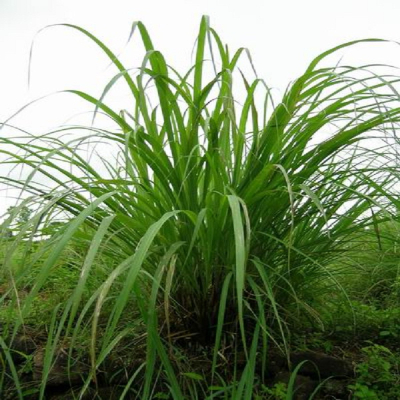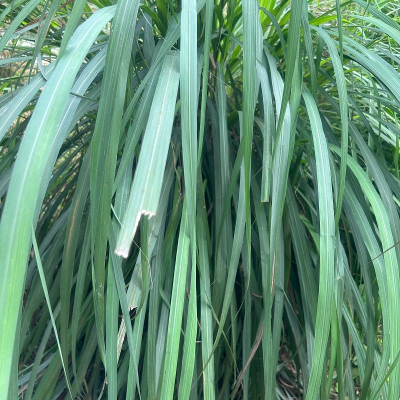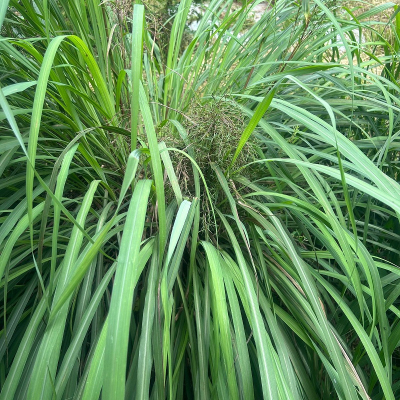Distribution and habitat: Distributed in Africa, Indian sub-continent, South America, Australia, Europe and North America. In India, they grow wild in all regions extending from sea level to an altitude of 4200 m. Several species are endemic to India.
East Indian Lemongrass is cultivated well in Kerala, Assam, Maharashtra and Uttar Pradesh. It is also distributed in Guatemala and China.
West Indian lemongrass originated either in Malaysia or in Sri Lanka. It is widely distributed throughout tropics and is grown in West Indies, Guatemala, Brazil, Congo, Tanzania, India, Thailand, Bangladesh, Madagaskar and China.
Jammu lemongrass is confined mostly to North Indian states such as Jammu and Kashmir, Sikkim, Assam, West Bengal and Madhya Pradesh. Lemongrass is cultivated in large scale at Chinnar wildlife sanctuary in Western Ghats of India.
East Indian, Cochin or Malabar grass. C. flexuosus
Botany: It is a tufted robust perennial grass of about 2 m height.
- Leaves: Linear and lanceolate.
- Flower: It flowers freely. Inflorescence is very large, highly branched, terminal, with drooping panicle bearing paired spikes on tertiary branches. Spikes bear spikelets in pairs of which one is sessile and other pedicellate. The sessile spikelet is an awned bisexual floret where as the pedicellate is an awnless staminate floret. Under this species, two varieties or types are identified based on colour of stem.
Properties: The oil is used in many pharmaceutical preparations such as pain balm and disinfectants, carminative, antiocholerin. Leaf- Stimulant, and anti-catarrhal. Lemon grass oil is basic raw material for manufacture of many aromatic chemicals, which are used in soap, perfumery and cosmetic industries.
Chemical constituents: Main constituent of the oil are citral-a, citral-b, and myrcene. Other contents are pinene, car-3-ene, dipentene, β-phelladrene, p-cymene, citronellal, β-elemene, β caryophyllene, citronellyl acetate, geranyl acetate, geraniol, elemol and linalool
Uses: Used in flatulence, digestive disorders, fever, menstrual disorder, rheumatism, other joint pains.
Agro-technology:
Soil and Climate: C. flexuosus flourish in sunny, warm, humid conditions of tropics. In Kerala, lemongrass grows well between 900 and 1250 m from mean sea level. It produces the highest oil yield/ tonne of herbage where the rainfall averages 2500-3000 mm annually.
In sandy loam and red soils, it requires good manuring. Calcareous and water-logged soils are unsuitable for its cultivation. Both species can be grown on a range of soils ranging from rich loam to poor laterite, good drainage is the most important factor. Plants growing in sandy soils have higher leaf oil yield and citral content. Although C. flexuosus flourishes in well drained sandy loams, in India, it is grown in almost all types of land available from very light sandy soil to upland laterites. Soils of pH 5.5 to 7.5 are utilized. In India, the highest herb and oil yields/hectare of C. flexuosus are obtained in soils of pH 7.5. Lemongrass grows and produces average herbage and oil yields on highly saline soils. In pot trials, C. flexuosus grown in soils with electrical conductivity of 11.5,10 and 5.5 mmhos/cm showed no significant reduction in herb and oil yield and citral content was unaffected by increasing salinity levels up to 15 mmhos/ cm.
Propagation: Generally propagated through seeds. Seed is mixed with dry river sand in the ratio of 1:3 and sown in field at the rate of 20 to 25 kg/ha. Alternatively, seedlings can be raised in a nursery in one-tenth of area of main field and transplanted after 45 days. This method which requires 3-4 kg seeds/ ha of main field is ideal for uniform stand and better growth of plants. Small plantation of lemongrass can be established by planting of slips. Propagation through vegetative means from selected clones is better as seed propagation tends to cause considerable genetic heterogeneity resulting in deterioration of yield and oil quality.
Seeds have dormancy of a few weeks and they lose viability in a few months. Seeds collected during January-February are usually sown in nursery during April-May. Germination is very poor after October. For one hectare of land, 1000 m2 nursery has to be raised. Area is made to fine tilth by repeated ploughing. Beds of 1 to1.5 m width and convenient length are prepared. Seeds are uniformly broadcasted on beds and covered with a thin layer of soil. Seed bed is irrigated frequently. Seeds germinate in 5-7 days.
A spacing of 30 cm x 30 cm with a plant density of 111000/ha is recommended. A wider spacing of 60 cm x 45 cm for seedlings and 90 cm x 60 cm for slips are recommended for fertile, irrigated land under North Indian conditions.
Manures and Fertilizers: Spent lemongrass compost at 10 t /ha and wood ash at 2 t /ha, which are obtained as by-products of grass distillation are applied at time of bed formation. Lemongrass requires 275 kg N, 50 kg P2O5 and 175 kg K2O/ ha/ annum. Under rainfed conditions of Kerala, application of 100 kg N in 3 to 4 split doses was optimum though a response up to 200 kg was recorded. Application of 50 kg/ ha each of P2O5 and K2O as a basal dose gave encouraging results in West Bengal. It is recommended to apply 60:45:35 kg /ha N, P2O5 and K2O basally and 60 kg N in 3 to 4 splits/ annum as top dressing during growing season as an optimum dose. It also responds well to application of copper, iron, calcium and sulphur. It was reported from CIMAP, Lucknow that a lower dose of boron (2.5 ppm) in combination with chloride salts (chloride salinity) is beneficial for crop.
In chromate overburdened soil, application of lime at 6 tonnes/ ha and fertilizer at 100 kg N, 50 kg P2O5 and 50 kg K2O/ ha produced higher plant height, tiller number and herb yield.
Irrigation: In case of drought, crop should be irrigated every alternate day for about a month after planting. It is recommended that 4 to 6 irrigation are given during February to June under North Indian conditions for optimum yield. Soil moisture regimes maintained at 0.80 IW: CPE ratio significantly increased crop growth, herbage and essential oil yields. Quality of essential oil is not affected by soil moisture regimes.
Harvesting: Harvesting is done by cutting grass 10 cm above ground level with sickles. Number of harvests in a year depends on climatological factors like temperature, rainfall and humidity and level of soil fertility. Generally crop thrives the best in humid condition. Cutting can begin as soon as nights dews have evaporated from plants, as wet grass left for later distillation quickly ferments. Sunny days are preferable, since cloudy and misty conditions tend to depress leaf oil content. First harvest can be taken at 90 days after planting and subsequent harvest at 50-55 days interval up to 5-6 years from same crop. During first year of planting, three cuttings are obtained and subsequently 5-6 cuttings per year. Harvesting season begins in May and continues till end of January. An herbage yield of 10-15 tonnes/ ha/ harvest may be obtained.
Lemongrass kept for seed purpose is not cut as yield of seeds from plants subjected to regular harvest is very low. Generally, plant flowers during November-December in plains and mature seeds are collected during January-February. A healthy plant produces 10 to 20 g of seeds. The whole inflorescence is cut and dried in sun and seeds are collected by thrashing against floor or beating with sticks. Fresh seeds are recommended for use in raising a plantation since seeds lose viability beyond six months of storage. Seed germination is very poor till May, increases up to July and thereafter decreases. Germination is meager beyond October.
Pest and diseases
Pests
A few pests are reported in this crop. Infestation by spindle bug (Clovia bipunctata) has been observed in Kerala and severe damage by a stem boring caterpillar of Chilotrea sp. under North Indian conditions is reported. Spraying mercaptothion (0.2%) controls insects. Nematodes like Tylenchorhynchus vulgaris, Rotylenchulus reniformis, Helicotylenchus spp. and Pratylenchus spp. also infect the grass.
Diseases
Common diseases and their causal agents are given below. These leaf diseases can be managed by prophylactic sprays of zineb @ 3g/l thrice, at intervals of 15 days or application of 0.2% copper oxychloride or 1% Bordeaux Mixture.
| Disease | Causal organism |
| Little leaf (malformation of inflorescence) | Balensia sclerotica (Pat) Hohnel |
| Leaf spot (eye spot) | Helminthosporium saccharii, H. leucostylum, Drechslera victoria and D. helm |
| Leaf spot | Curvularia andropogonia (CLS) |
| Leaf spot | C. veruciformis, C. trifolii and Collitotrichum graminicola |
| Leaf spot and clump rot | Fusarium equiseti and F. verticillium |
| Leaf blight | Curvularia andropogonia (CLB) |
| Leaf blight | Rhyzoctonia solani. |
| Grey blight | Pestalotiopsis magniferae |
| Smut | Tolyposporium christensenni and Ustilago andropogonis |
| Root rot | Botrydiplodia theobromae |
Helminthosporium cymbopogi cause very serious disease in low lands of Guatemala. Brown top disease causes browning and curling of affected leaves. This is a physiological disease resulting from low water content of grass at end of dry season. Symptoms of rust disease of lemongrass causing elongated, stripe like, dark brown lesions on both sides of leaf surfaces have been described. Causal organism is Puccinia nakanishikii. Root segments of lemongrass were heavily infested with multiple vesicular arbuscular mycorrhiza (VAM). Moreover, brown septate hyphae of non-mycorrhizal fungus also co-existed with VAM in 50% of root segments. Burning of stubbles in summer is practised in some areas to ward off pests, diseases and weeds.
Leaves become smaller in size and flowers in inflorescence get converted to very small leaves in case of little leaf caused by virus. Removal and destruction of such plants should be resorted to, to reduce spread of disease and avoid collecting seeds from such plants.
Processing:
Lemongrass oil is collected by steam distillation of herbage. Distillate on cooling separates out into a layer of oil, floating over bulk of water. For obtaining good quality oil, steam distillation in stainless steel units is preferred at a steam pressure of 18-32 kg/ cm2 in boiler. Grass is distilled either fresh or after wilting. Wilting herbage prior to distilling reduces moisture content and increases oil recovery. Drying in sun reduces oil recovery but has little effect on oil composition. Generally, Clevenger apparatus is used for distilling small quantities (up to 1.0 kg) of herb in laboratory. Field scale distillation units are fabricated to distill 500 kg or more of the herb at a time. On an average, herbage of C. flexuosus contains 0.2-0.4% oil and oil yield is 100-125 kg/ha/year. Distillation being a high temperature process, yields an oil with burnt note. Also it is devoid of volatile fractions. An oil of softer note is yielded by solvent extraction. However, the process is more expensive than steam distillation. Residue obtained after extraction of oil is called spent grass. It can be used as cattle feed fresh or after ensilaging. It can be used for mulching or manuring crops as such or after composting. In some plantations in India, spent lemongrass after drying is used as a fuel for distillation. It is also a cheap packing material. Spent grass on an average contains N 0.74%, P 0.07%, K 2.12%, Ca 0.36%, Mg 0.15%, S 0.19%, Fe 126.73 ppm, Mn 155.82 ppm, Zn 35.51 ppm and Cu 56.64 ppm.
Oil of lemongrass is a viscous liquid, yellow to dark yellow or dark amber in colour turning red on prolonged storage. Presence of water imparts a turbid appearance. Whole oil is mainly used as a source of citral. Differentiation of lemongrass oils into West Indian and East Indian in trade has no geographical significance, as oils from both species are produced in these areas. However, the West Indian oil has less citral and more myrcene than East Indian oil. Although both oils have a pronounced fresh lemony fragrance, odour of East Indian is stronger. East Indian is considered fresher, lighter and sweeter.
Morphological characters like plant height, number of tillers/ plant and number of leaves/ plant is significantly correlated with essential oil yield/ plant. Maximum elimicin content is seen at flowering stage. Among the physiological characters, a significant correlation was observed between essential oil content and crop growth rate (r=0.6018) as well as net assimilation rate (r=0.9474).
Oil of lemongrass is chemically reactive. The terpene mixture undergoes a series of complex reactions when exposed to air and sunlight. It is slowly converted into a dark coloured viscous resinous substance on keeping. However, if stored in aluminium or stainless steel vessel with out contact of air, water and light, quality of oil is stable for long periods.




